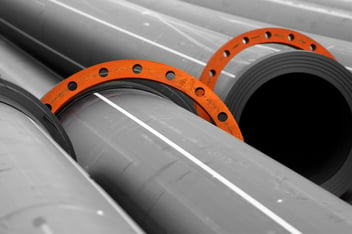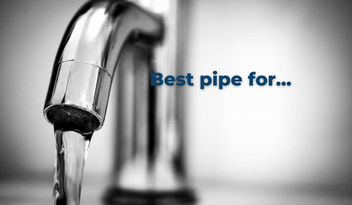Top tips to ensure a safe and successful PVC system design
Chances are that wherever you are right now, theres a hidden network of pipes running right beneath your feet. These unsung heroes, play a role in our every-day lives transporting the essential fluids and gases fueling our buildings, industrial infrastructure, machinery, and other everyday conveniences.
However as simple as these piping systems may appear, their journey to becoming a seamless system is far more intricate than we may realise. While building a pipeline to transport fluid may seem straightforward, designing an efficient, economical, and safe system requires careful planning. This blog outlines 5 important design tips for designing a PVC pipeline of any size or application, ensuring a safe and successful installation.
Design Tip 1: Pipe sizing matters.
Often misunderstood, pipe sizing is an essential player in designing an efficient piping system. Whether it be liquid under pressure or simply a drainage system, ensuring that the diameter of your pipe is correct, will ensure the necessary volume of liquid can be safely transferred at the desired flow rate. If you’re ever in doubt, there are flow tables available for various piping materials and these should be consulted to select the right pipe sizing. As a guide, at a given flow rate, the smaller the pipe the greater the pressure loss through friction. Conversely, the larger the pipe the lower the pressure loss through friction. The use of larger pipes translates to a more energy efficient system by reducing lost energy.
In wastewater transfer or drainage applications it is important to have appropriately sized pipes to obtain the preferred velocity of the liquid through the pipes, to prevent solid matter from building up on the pipe walls. When designing the system, it is super important that you consider this, because if the velocity is too slow, solids can tend to build up and reduce the effective bore size of the pipe making your system design less effective in transferring liquids at your desired flow rate.
Design tip 2: Not all PVC pipes are created equal - how to determine the strength capability of your system.
Ever wondered why there are so many different types of PVC pipes? The wide variety of PVC pipes exists for a reason: to handle different strengths and pressures. Different PVC pipes have varying strength capabilities, depending on two key factors: material compositions and how thick the pipe wall is. Whilst PVC-C, PVC-M and PVC-O is available, the most common material is PVC-U. Now with PVC-U pipes theres another key factor to consider: pressure rating. The heavier the wall thickness the higher the pressure rating or PN rating.
Heres a tip for determining the correct pressure rating: In design, the correct rating can be determined according to the system requirements and the pipe rating should exceed these requirements.
Why the safety margin?
Simple – underestimating pressure is a recipe for disaster. Poorly calculated pipe system design is likely to result in early failure and costly maintenance. By designing with a safety margin, you ensure your system runs smoothly for years to come.
So how can you avoid this potential outcome and choose the right strength capabilities for your system?
For PVC drainage pipes, the heavier the wall thickness the higher the stiffness rating or SN rating. As a guide low SN pipes are typically used for domestic and light duty applications, whereas high SN rated pipes are typically used for high load or Civil applications such as roadways. To be sure your system has the correct strength capabilities for the pressure requirements, check out the following resources based on the material of your system.
If you’re designing a different kind of PVC system to those listed above, we can still help! Our knowledgeable support team is happy to assist you in determining the appropriate PN or SN rating for your specific applications. You can contact us here!
Design Tip 3: Support your pipes to reduce stress and limit pipe movement
If the PVC piping system is installed above ground, then when you’re designing the system consideration should be given to pipe support to reduce stress on pipes and limit undesired movement. To determine the optimal pipe support spacing for your project, consult the manufacturers recommendations according to pipe size. To help you determine this, check out these resources:
It is important to follow these recommendations for system reliability and to ensure a long service life. Skipping these crucial supports and not accounting for thermal expansion can lead to:1. Increased Pipe stress: Failure to observe and not allow for piping support and expansion may result in pipe stress.
2. Cracking and leaks: Overstressed pipes are more prone to cracking, causing leaks and system failure.
3. Premature System failure: Without proper support, your PVC system might not reach its expected lifespan.
Remember, pipe brackets should provide support whilst allowing necessary movement due to thermal expansion and contraction.
Design tip 4: Determining material compatibility with the transferring medium
PVC pipes are known for their versatility, handling many chemicals effectively. This making them a good choice for waste transfer and light to medium chemical applications. It is important to understand the composition of the fluid to be transferred to determine the correct system materials and so the system can be designed accordingly. An example of where PVC pipes are not recommended and should not be used, is compressed air applications. Whilst it is a relatively low-cost piping system, it is considered too brittle for compressed air and is likely to end up costing you in the long run. Fluids cannot be compressed and therefore PVC pipes are usually safe when used correctly, however as air can be compressed, this can result in severe swelling of the pipework. A simple external knock or force applied can result in the pipework exploding with the risk of equipment or even bodily harm. So hence why is it really important that you do your research on the properties of the transferring medium before choosing the material for your system.
Design tip 5: Design with temperature in mind.
Just like you wouldn’t use a plastic cup for hot coffee, there are different types of PVC pipes designed for different temperature ranges. Picking the right one for your project is key to ensuring the safe transfer of fluids, this is a really important factor in the design phase which could have an effect on the material and pipe size you select. For example, PVC-U is suitable as a pipe material up to approximately 60°C and at this point the pressure rating is greatly reduced. Beyond this temperature the pipe will lose its structural rigidity and is not safe to use, so it wouldn’t be an ideal choice for higher temperature applications. For higher temperature applications you might consider PVC-C which is suitable for some applications up to 93°C.
Here are few things to keep in mind:
1. Piping system design should always consider both fluid and ambient temperature as once the pipe material exceeds 23°C, the pressure rating must be reduced due to material beginning to soften.
2. PVC should not be used below 4°C as the pipe becomes too brittle and can shatter easily.
Overall PVC pipe is a cost-effective and easy-to-use piping material, however its crucial to consider the projects system requirements during the design phase to ensure it is the most suitable option for any given application.
If you still have any questions, give the team at Waterworks a call and speak to one of our experienced consultants who can guide you through any questions to achieve optimal results for your project.

-1.png)

.png?width=352&name=Waterworks%20%20PE%20vs%20PVC%20(1).png)

